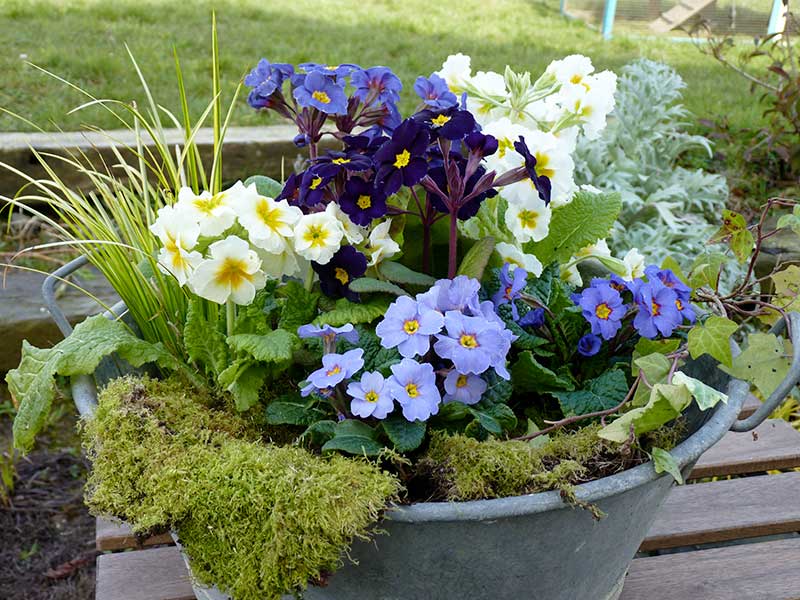Growing Primula
Soil
All the Primula we list do best in neutral or slightly acidic soil. As a general rule they like a partially shaded position and large quantities of organic matter.
Primroses
Where to plant in the garden

Photo © Mona Larochelle photographe
Barnhaven primroses, acaulis and polyanthus forms and julianas are bred to be tolerant of a wide range of conditions, but they are descended from woodlanders and are happiest in humus-rich, well-drained soil which does not dry out. The ideal location for them would be on a slope under deciduous trees, - or in a north-east facing bed. Full sun on frozen foliage, alternating freeze / thaw conditions, waterlogging in winter, or hot dry conditions in summer will all punish the plants. Barnhaven primroses are very hardy and do not need protecting from frosts or snow, however if you experience particularly harsh winters with not much snow cover, a loose covering of leaves or straw can help protect the plants.
Primroses like a rich soil, so use plenty of fertilizer such as well-rotted horse-manure, chicken manure pellets or blood and bone mixtures when planting. A regular mulch can help keep in humidity and feed the plants.
Growing in pots

Primroses are easy to grow in pots, troughs or other containers in partial shade. For best results use a general purpose compost and keep the containers well-watered. Feed the plants with a weak solution of high potash or tomato fertiliser every ten days from the time the buds start to form until the first flowers open. A 'thank you' feed when flowering ends is recommended, but don't feed late in the season and don't use a high nitrogen fertiliser. Keep cutting the stalks of the spent flowers and they will keep producing more. When the pots have finished flowering simply place them in the shade and keep them watered over the summer months.
Propagating
A lot of primroses will self- seed in the garden but be aware that as they are hybrids the new seedlings will not come true to the original mother plants they will cross with other primroses in your garden or in the area.
Whether grown in pots or in the garden, dividing the plants every two or three years helps keep the plants vigorous and is a good way of multiplying the plants. See our page on dividing primroses for more information.
Double Primroses

Photo © Mona Larochelle photographe
They require the same conditions as the polyanthus and primroses described above, but a little extra kindness will be repaid. Doubles don't have the ability to set seed, but the plant will keep producing blooms in an effort to do so, - sometimes as many as a hundred!! This exhausts the plant and they need to be helped with extra feeding and watering. Picking some of the blooms also helps - they keep well in water. Some organic manure with a higher nitrogen content is welcome, and moisture must be watched during dry periods in the summer. Because no seed is set, old blooms linger on the plant and can cause rot in the crown. Watch out for botrytis and spray if there is any sign of it. Divide the plants every two years to keep them vigorous and to produce more plants.
Primula sieboldii

Photo © Mona Larochelle photographe
Japanese primroses are also woodlanders. They like dappled shade under deciduous trees, with humus-rich, moist, well-drained soil. They do not do well on alkaline soil (chalky soils). They form large spreading root clumps so they need space to develop. Their leaves begin to die down in August, so mark their position. While there may be little evidence of the plant above ground, the root structure is alive and well and working for next year below the surface. A top-dressing of an ericaceous compost helps.
They are often grown as pot plants in Japan, and do well in well-drained compost that shouldn't be allowed to dry out. Simply place them in a shaded place in the garden when they have finished flowering and divide them every couple of years, discarding the centre part of the plant which usually dies back naturally.
Candelabras and Belled Primula
Candelabras and belled Primula are easy to grow and will develop into large clumps that self-sow profusely if they are planted in nutritious moist soil that does not dry out. They are ideal for a bog garden/ in full sun, - or a damp spot beside a stream. They also do well in groups in acid beds used for rhododendrons or azaleas. Most Asiatic species lose their leaves in winter and will go dormant forming a resting bud that is barely visible at the surface of the soil. Very hardy plants, they will tolerate cold winters as long as they are not completely waterlogged.

They will self-seed profusely and hybridise with each other to create a multi-coloured tapestry of flowers.
Alpine Primula
Most alpine Primula originate from the mountainous regions of Europe and will do well in the garden as long as you ensure that their natural conditions are replicated as much as possible. Good drainage is a must and water-logging will be fatal. The plants are used to windy slopes, snow cover in winter (so fairly dry and cool), wet conditions in the spring as the snow melts and cool temperatures. Therefore most plants can be grown in shady rockeries, pots or troughs with grit or river sand added to aid drainage. Some may be best grown in pots to control the moisture content in the winter when they can be prone to rot.
Primula allionii
Primula.allionii and its hybrids are generally grown in an alpine house. A gritty compost is recommended, with a top dressing of limestone chips to keep the neck of the plant from going soggy. Mostly happiest in shallow pans, but don’t overpot. Summer: keep as cool and airy as possible, and water just enough. Autumn: restrict watering and watch for fungal attack. Winter: remove dead and decaying leaves and keep fairly dry. Spring: enjoy, give some gentle feeding and remove dead flowers after flowering. A good time to re-pot.
Primula marginata
Primula .marginata and its hybrids are very hardy. With good drainage they grow well in a trough, crevice or rock garden but for their full glory to be appreciated they are often grown in a cold greenhouse where the beautiful farina on their leaves is protected from the rain. Seasonal care as above.
Garden auriculas
Garden auriculas include Alpine, Border, Double and Striped auriculas. They are raised to be hardy and to survive without the special cossetting that is sometimes required by show auriculas. They grow well in a normal soil, either in pots, troughs or in a well-drained border or rockery. The main thing is to make sure the soil is well-drained and that they are in a semi-shady spot.

Auriculas growing in an old ceramic sink with saxifraga.
If your soil is heavy, add some small gravel to the compost mix and a gravel mulch around the plant will help to avoid rot if the winter is wet. Try to remove dead leaves which fall on your plants. For the best flowers, give a low dose of tomato feed every week as soon as you see new buds, until full flowering. We would suggest dividing them every couple of years and enriching the soil with well-rotted manure or compost when you replant them. We do not recommend covering the plants in winter. They are hardy alpine plants that are used to being under a layer of snow in the winter.
Show Auriculas
To safeguard the spectacular beauty of the Show auriculas (Selfs, Fancies and Edges). it is often usual to keep them in pots either in a well ventilated and shaded alpine house, or in pots with some sort of protection outdoors in the winter for example an outdoor veranda, or on a north-facing window ledge. They don't mind the cold, only excessive wet and the rain on the flowers can wash the farina away. Often displayed in 'theatres' or shelving units in the spring they will make a lovely show and can be moved to a less prominent and shadier place in the summer months.

© Colin Humphrey, National Auricula and Primula Society Kent group.
Here is a brief summary of our own Show auricula year :
Spring - we start to water the plants little by little as the weather begins to warm up, keeping them just moist. As the buds appear we begin to give a small amount of tomato fertiliser, until flowering.
Late spring - after the flowers have finished we re-pot into fresh compost*. If there are rooted offsets we remove them carefully and pot them on into small pots. It’s important not to give your auriculas too large a pot. They do seem to like their roots a bit constrained. We then put the pots into the shade and keep them just moist. This can also be done in the autumn, depending on your local conditions. See the page on Dividing Primula for more information.
Summer - do not overwater. Leave the pots to dry out in between watering. If the weather is very hot and dry, watch out for spider-mite (tiny red insects that leave spider-like webs on the underside of leaves). This can avoided by misting the leaves during very dry periods or use predatory mites that feed on them.
Autumn and winter – not a great deal to do apart from keeping them just damp enough to stay alive. You do not need to worry about frost; auriculas are fully hardy to -20°C.
All year - removing dead leaves and stems that come away easily does help to avoid rot. Keep an eye out for green fly, and root aphid. The root aphid appears as white fluffy insects around the roots of the plants and the neck. See our page on Pests and diseases for more information.
* Compost: each grower has his own recipe but the emphasis has to be on good drainage. We use a mixture of a very open peat based compost, mixed with vermiculite and gravel.
















































